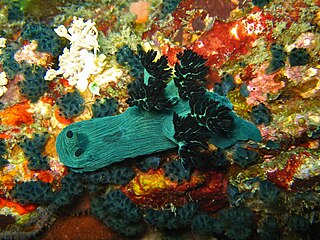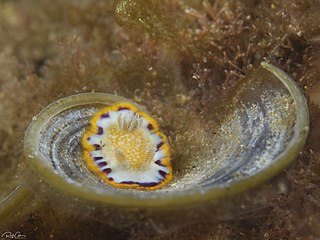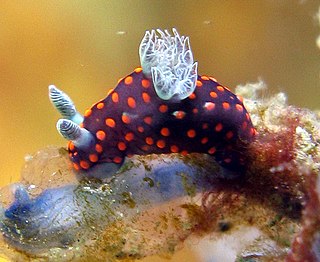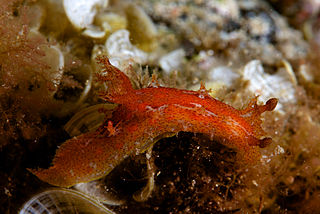
Nembrotha lineolata is a species of nudibranch, a sea slug, a marine gastropod mollusk in the family Polyceridae. It is found in shallow water in the Indo-Pacific. It was first described in 1905 by the Danish malacologist Rudolph Bergh. The type locality is Selayar Island, Indonesia.

Nembrotha kubaryana, also known as the variable neon slug or the dusky nembrotha, is a species of colorful sea slug, a dorid nudibranch, a marine gastropod mollusk in the family Polyceridae.

Nembrotha cristata is a species of colourful sea slug, a polycerid nudibranch, a marine gastropod mollusk in the family Polyceridae. This species of sea slug is black with green markings; adults are around 50 mm in length, and they live on rock or coral reefs in the tropical Indo-West Pacific Ocean.

Nembrotha chamberlaini is a species of colorful sea slug, a dorid nudibranch, a marine gastropod mollusk in the family Polyceridae. It was first described in 1997.

Nembrotha purpureolineata is a species of colourful sea slug, a dorid nudibranch, a marine gastropod mollusc in the family Polyceridae. Nembrotha rutilans, classified as a separate species until 2008, has now been reclassified as Nembrotha purpureolineata.

The crowned nudibranch is a species of dorid nudibranch. It is a marine gastropod mollusc in the family Polyceridae.

The tasselled nudibranch, scientific name Kaloplocamus ramosus, is a species of sea slug, a dorid nudibranch, and a marine gastropod mollusc in the family Polyceridae.

Nembrotha milleri is a species of sea slug, a dorid nudibranch, a marine gastropod mollusk in the family Polyceridae. This species was named after the nudibranch enthusiast Michael D. Miller.

Tambja sagamiana is a species of colourful sea slug, a dorid nudibranch, a marine gastropod mollusk in the family Polyceridae.

Goniobranchus obsoletus is a species of colourful sea slug, a dorid nudibranch, a marine gastropod mollusc in the family Chromodorididae.

Thecacera pacifica is a species of sea slug, a nudibranch, a marine gastropod mollusk in the family Polyceridae. It is sometimes also nicknamed Pikachu nudibranch due to its resemblance to the Pokémon character Pikachu.

Gymnodoris ceylonica is a species of sea slug, a dorid nudibranch, a marine gastropod mollusk in the family Polyceridae.

Nembrotha aurea is a species of colourful sea slug, a dorid nudibranch, a marine gastropod mollusk in the family Polyceridae. It was first described in 2008.

Nembrotha megalocera is a species of colourful sea slug, a dorid nudibranch, a marine gastropod mollusk in the family Polyceridae. It was first described in 1990.

Nembrotha livingstonei is a species of colourful sea slug, a dorid nudibranch, a marine gastropod mollusk in the family Polyceridae. It was first described in 1933.

Nembrotha yonowae is a species of colourful sea slug, a dorid nudibranch, a marine gastropod mollusk in the family Polyceridae. It was first described in 1992.

Nembrotha mullineri is a species of colourful sea slug, a dorid nudibranch, a marine gastropod mollusk in the family Polyceridae. It was first described in 1997.

Plocamopherus maderae is a species of sea slug, a nudibranch, a shell-less marine gastropod mollusk in the family Polyceridae.
Thecacera darwini is a species of sea slug, a dorid nudibranch, a marine gastropod mollusc in the family Polyceridae.
Tyrannodoris ricei is a species of sea slug, a polycerid nudibranch, a marine gastropod mollusc in the family Polyceridae.



















